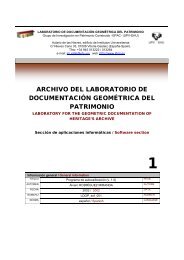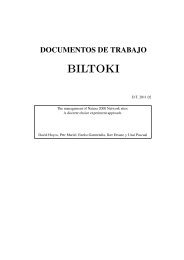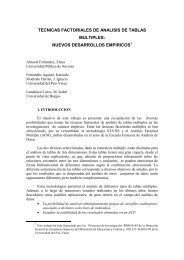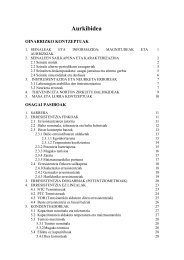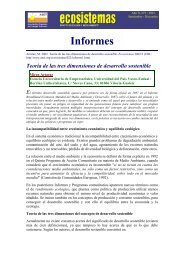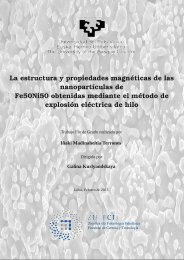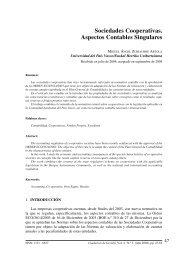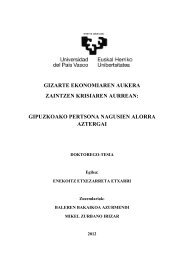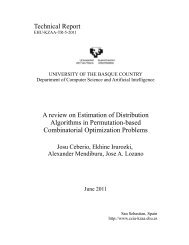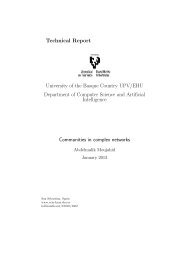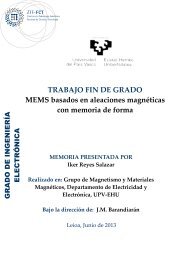Ï - ADDI
Ï - ADDI
Ï - ADDI
- No tags were found...
You also want an ePaper? Increase the reach of your titles
YUMPU automatically turns print PDFs into web optimized ePapers that Google loves.
4.2. Organic adsorbates chemisorbed on graphene: Universal spin moment 93and the adsorbate increases we observe a smooth transition from a magnetic to a non-magneticsystem that in part reflects the partial polarization of the covalent bond between the carbon hostand the adsorbate (charge transfer). In order of increasing electronegativity, the C-X(N, O, F)bonds (see Table 4.1) show an increasing polar behaviour compared to the C-C bond. Thus, Hor N bonds that do not have a considerable difference in electronegativities respect to C presentspin-uncompensated solutions and an electronic structure quite similar to the C-C bond; but forC-O and mainly C-F bonds, where the latter has the largest difference in electronegativity, thesystem suffers a drastic reduction of the spin moment or even reaches a non-magnetic groundstate. Nevertheless, careful calculations using fixed spin moment method (FSM), indicated inparentheses in Table 4.1, show that the energy penalty needed to develop a spin solution issmall even for our most polar bond (E M = −24.1 meV for C-F).Therefore, this indicates that the C-F bond could easily be polarized by an external perturbations(e.g. magnetic field), so that graphene covalently functionalized with F can show astrong magnetic susceptibility 1 .To visualise the spin polarization induced by the adsorbates on the graphene lattice, we plotthe magnetization density in Figure 4.2: (b) Adenine group, (c) CH 3 , (d) Pmma polymer chainand (e) PTFE. It is remarkable to observe that in all the panels a molecule bound to the carbonsurface is stabilising a spin pattern in the neighboring carbon atoms with a clear p z -like shape.The sign of the spin polarization follows the bipartite character of the graphene lattice: carbonspins polarize parallel (antiparallel) respect to the C atom that binds to the surface when sittingin the opposite (same) sublattice. The total spin moment is 1.0 µ B and a Mulliken analysisassigned to 0.34 µ B in the three first C 2 nearest-neighbors (see Fig. 4.2(a)), -0.13 µ B in thenext nearest-neighbors, to 0.26 µ B in the third-neighbors, and to 0.40 µ B integrated over largerdistances. The saturated carbon atom (C 1 ) in graphene and the carbon atom in the adsorbatethat bonds to the layer, show a local spin polarization smaller than ∼0.10 µ B .We now look at Figure 4.3 which shows the calculated density of states (DOS) per spinchannel for different chemisorbed adsorbates at the graphene surface. Despite of the curveshave been shifted and smoothed with a Lorentzian broadening, the data over the whole energyrange collapse onto a single pattern. This confirms the universality of the origin of the spinmoment in covalently functionalized graphene, independently of the particular type of adsorbate.Chemisorbed H also shows the same DOS. Variations from these collapsed curves canbe observed for adsorbates with different bond character from a single covalent C-C bond (notshown in Figure 4.3). These results point out the analogy between a C-H bond and a C-C bondof adsorbates, which in principle, is not an obvious behaviour.It is interesting to note that notwithstanding the biological and chemical activity, differentadsorbates present several common points that are worth mentioning in Table 4.1 and Figure4.3: (i) All the molecules induce a spin moment of 1.0 µ B that is fairly independent of thesupercell size and is mainly localized at the graphene layer; (ii) The origin of the spin polarizationcorresponds to the p z -defect state, as was explained above by analysing band structurefor two of them; (iii) The δE s varies in a small range 0.19-0.24 eV, what really points to a verysimilar localization of the defect states on all the studied systems.1 In particular for C-F bond, the FSM calculations indicate an energy cost of less than ∼2.0 meV to create aspin moment of 0.50 µ B in a 8×8 graphene supercell. This tiny energy value reaches the accuracy limit of thecalculation which means that a spin polarized solution is equally possible even at the ground state.



